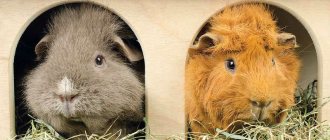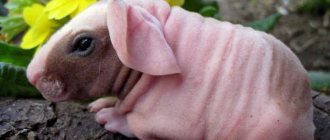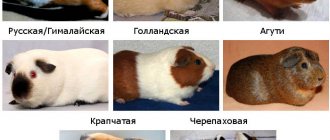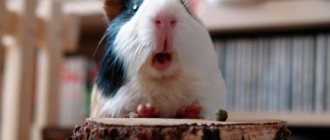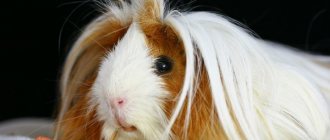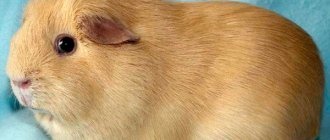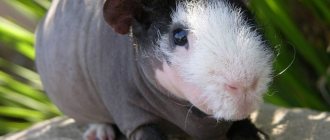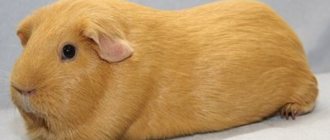Guinea pigs are ideal for keeping as pets. There are a variety of pig breeds, however, special attention should be paid to the Peruvian guinea pig.
The history of the emergence of this species is lost in the depths of past centuries. It is only known that the first representatives of the breed were brought to Europe in 1800 from the countries of South America - Peru, Argentina or Brazil.
The general public became acquainted with the animals at the Paris Agricultural Exhibition, after which a breed standard was formulated and approved in 1930.
Story
Where do the Peruvian breed of guinea pigs come from, how did they appear? Why do they have such long fur? Due to the unusual appearance of the rodent, it can be assumed that Peruvian guinea pigs were bred artificially, like, for example, the skinny breed. But no, “Peruvians” appeared in nature, naturally.
Peruvian guinea pigs are native to South America; to be more precise, according to scientists, they are from Bolivia, Argentina and, of course, from Peru - it is from the place of passage that their name appeared. In the 16th century, this breed was brought by traders from Europe to France. In this country, pigs were kept as pets and were worth a lot of money. These pigs also came to other European countries and to the UK from France, to subsequently become an attribute of fashion and win the hearts of people and the interest of breeders all over the world.
In Europe, the popularity of this breed reached its peak in the mid-19th century. For the first time, at an exhibition of agricultural goods in Paris at the end of the 19th century, these animals were presented to the public and captured in photographs. Initially, only three breeds of pigs were exhibited in America: Abyssinian, smooth-haired and long-haired Angora. In the 1930s, the breed name "Angora" was changed to "Peruvian", resulting in confusion that continues today. In some countries, when breeding this breed, it is still given the name “Angora”, with standards and rules specifically for the Peruvian breed.
Currently, this breed of guinea pigs is officially recognized in many countries. In the Russian Federation, such pigs are also quite popular. Despite the fact that many breeders breed this breed, it is not so easy to find them for sale.
Appearance
The Peruvian guinea pig has such a bright and impressive appearance that it is almost impossible to make a mistake and confuse it with representatives of other breeds. The main distinguishing features of the animals:
- short body;
- large head;
- broad shoulders.
And pride and, undoubtedly, the main distinguishing feature of the Peruvians is their completely straight, thick and unusually silky fur, up to 15–20 cm long. The coat is so thick that, looking closely at the animal, you cannot immediately determine where the muzzle is and where the tail is.
And of course, many people think that caring for wool of this quality is a difficult and troublesome task. Practice shows that this is not entirely true. The fur does not tangle and is very easy to comb. It's all about the rosettes, of which Peruvians have 2 on the body and a peculiar swirl on the nose. The rosette in pigs is the starting point for the growth of fur in a circle.
On the head, strands of fur fall over the eyes, covering almost the entire muzzle of the rodent. On the back, the fur is placed in an even parting. But on the paws and belly the fur is very short, and it’s easy to care for.
Peruvian guinea pigs come in a variety of colors and patterns. For example, one-colored Peruvian selfies and two-colored pigs are known, but a three-colored animal is a rare curiosity.
Adult animals grow up to 1.8 kg. With proper care, the life expectancy of animals is about 8 years.
Behavior
Peruvian guinea pigs have a fairly calm character. They are friendly, welcoming, love affection and care, and enjoy playing.
Peruvians simply need to play and exercise a lot to keep them in good health, so games are not only fun, but also a guarantee of good health, so let your pet play and run around more often.
Despite the fact that pigs are playful and move around a lot, they prefer rest and a calm environment. Rodents feel uncomfortable when there is a noisy environment and a lot of movement. They need to be treated with care, and having small children in the family is not the most suitable option for them.
Purchase rules
You can buy a real Peruvian guinea pig as a pet only in specialized nurseries. Otherwise, you may fall for a “fake”. This will not make the animal worse or more beautiful, but it will still be a shame for the money spent.
Before the transaction, they check the presence of all documents, find out about the animal’s parents and make sure of the noble origin of the rodent. At the same time, they agree with the owners of the nursery about the opportunity to consult if necessary. Usually employees agree to this with joy, since they, too, are not indifferent to the fate of the “child.”
Pregnancy and offspring
Guinea pigs give birth without much difficulty. The pig reaches sexual maturity at 5 weeks after birth, and males at 10 weeks. Despite this, a female should not give birth early, as this may cause harm to her. The most suitable period for breeding is after 12 weeks.
But giving birth too late can also be unsafe. It is prohibited to breed guinea pigs if the female is over two years old. The pregnancy of this rodent lasts an average of 63 days; in one birth, the female gives birth to 2–4 babies. They are born strong and strong and immediately after birth they are able to move independently. After birth, little pigs need to be housed separately for 3-4 weeks.
Reproduction
The main difficulties associated with breeding these animals at home are the correct selection of a pair to ensure the birth of healthy and strong offspring. Animals that have reached six months of age, but not older than two years, are allowed to crossbreed.
Females come into the hunt, which lasts about 12 hours, on average once every 15 days. Gestation of the cubs takes 68 days. In this case, one female gives birth to two to four pigs.
Description
Peruvian guinea pigs are a long-haired breed. Among all Peruvians there are also translators. These are animals that resemble Peruvian pigs in appearance, but their roots are very dubious. Therefore, before visiting a pet store, breeders need to learn how to distinguish purebred representatives from mixed ones.
It is worth remembering that real purebred Peruvian pigs can only be purchased in a nursery. Otherwise, you risk becoming a victim of charlatans. Of course, the animal will become beautiful and will delight you with its decorativeness, it’s just a pity for the money spent.
Before purchasing an animal from a nursery, the future owner has the right to request documents for the animal to verify the origin of the rodent.
These animals are medium in size. The body is downed, the head is small, the skull is well developed. Experienced breeders claim that Peruvian guinea pigs are calm, friendly, and this makes them different from their relatives. They get along well with people and are easy to train and tame.
Article on the topic: Hairless guinea pigs Skinny and Baldwin - photos and descriptions of hairless breeds of pets similar to hippos
Distinctive features
The characteristic features of this breed include:
- long thick fur, reaching 30-40, and sometimes 50 cm;
- parting on the back, starting from the neck and ending with the coccyx;
- long bangs hang over the face, blocking the animal’s entire view;
- in the sacrum area there are two rosettes;
- there is a small swirl on the nose;
- these rodents do not have a tail, and their body length is about 30 cm;
- the weight of an adult is 1300-1500 g;
- the body is dense, massive;
- the ears are small, slightly hanging forward and somewhat similar to flower petals;
- the abdomen and legs are covered with short hair;
- the paws are straight, the toes are mobile;
- The eyes are black and round like buttons.
Both outlets are beautifully shaped and clearly separated from each other. Bundles of hair grow in the same direction. The hair grows from back to front, forming long and thick bangs.
Colors
Peruvian guinea pigs come in a variety of colors. It is rare to see monochromatic animals. Often these are two-, three- and even four-colored animals with shiny and thick long hair.
The lifespan of domestic pigs depends on their diet and living conditions. With good care, a Peruvian guinea pig can live for 5-6 years.
Considering that Peruvian guinea pigs have long hair, the owner needs to regularly groom it. All care consists of daily combing of long hair. For these purposes, use a wide-toothed comb and a soft brush. If you comb such a pig nicely and lay it on a pillow, it will look like a wig.
In addition to brushing, these animals need to be trimmed periodically. After a haircut, the Peruvian guinea pig looks well-groomed and feels comfortable.
Pigs can be trimmed
This breed is more suitable for exhibition centers than for children to keep at home. This is explained by the fact that caring for animal fur requires patience and meticulousness, which many owners simply lack. Therefore, a Peruvian guinea pig living at home often looks unkempt and unattractive.
Article on the topic: The largest rat in the world: photos of giant and rare individuals
You can bathe animals, but in very rare cases, for example, if they are being prepared for an exhibition. For washing, use a special shampoo and conditioner. After bathing, the animal is thoroughly blotted with a towel and dried with a hairdryer. At this moment, it is very important to prevent hypothermia, otherwise the animal may get sick and even catch pneumonia.
Maintenance and nutrition
A guinea pig is not small in size, so it needs a fairly large cage - 70 by 80 cm and a height of 50 cm is perfect. The pig is quite large and for comfort it needs a lot of space to move freely. The cage with the animal must be placed in a well-lit, windproof place.
The animals have good immunity, but despite this, they should not be in the cold, as they can catch a cold - even though they have thick and warm fur. From time to time, you can let your guinea pig run around the house outside of its cage. But be sure to keep an eye on it - the animal may crawl or hide somewhere, and then you will have to work hard to find it.
Peruvians also have rather sharp teeth. Therefore, if you have released an animal, be prepared for the fact that it may chew on the wooden furniture in the house. Pigs' teeth do not stop growing throughout their lives, so it is necessary to give your pets solid food so that their teeth wear down and are not too sharp.
Nutrition
Guinea pigs' food should consist of the following products:
- corn;
- hay;
- grass;
- seeds;
- vegetables and fruits;
- special treats for guinea pigs from specialized pet stores;
- dry food in granules.
The animal needs to be fed twice a day, preferably in the morning and evening. Feeding the pig multiple times is allowed, but in small portions. In the warm season, one adult guinea pig eats about half a kilogram of fresh grass and 50 grams of oats per day.
As an additional supplement, 20 grams of milk are introduced into the diet of pregnant and lactating guinea pigs. The diet of guinea pigs is periodically enriched by adding vitamin-mineral complexes to the food.
Guinea pigs eat everything that other rodents do: fruits, vegetables, grass or old hay. Peruvians especially love to eat apples because they are juicy and sweet. Apples also contain a lot of vitamin C, which is essential for animals. By the way, vitamin C is found in large quantities in hay.
You can also feed the pig with specialized food, which is sold in pet stores. It also contains many useful substances that the animal needs both to maintain health and for the beauty and thickness of its coat.
Reproduction
Breeding purebred Peruvian pigs is not an easy matter. Difficulties in this process are more related to the selection of parents than to the process of reproduction itself. Therefore, experienced breeders recommend trusting professionals in this matter.
Animals are crossed at the age of six months and no later than two years.
Article on the topic: American Teddy Guinea Pig - photo and description of the breed
In females, estrus occurs every second week and lasts for 12 hours. During this time, you need to have time to match the female with the male.
Pregnancy lasts 9-10 weeks. In one litter, a female can give birth to two to six babies. They live with their mother for up to three weeks and feed on her milk. They are then transplanted into a separate cage.
Guinea pig care
The Peruvian guinea pig requires more attention than, for example, a representative of the short-haired breed, so it is advisable to get a Peruvian when you already have experience in keeping guinea pigs.
It is also not recommended to have such a pet for children. If a child really wants a rodent, give him a smooth-haired pig - there will be less worries with it, and the same pleasure. Breeding Peruvian guinea pigs should be carried out by enthusiasts or people who have experience in this matter, as well as the desire and ability to do this.
Peruvian pigs need to be brushed and combed every day , if desired, do this several times a day. The pig should be combed with a simple baby or small comb. Special combs, which you can purchase at a pet supply store, are also perfect. If your plans do not include exhibiting your pet at exhibitions and demonstrations, then it is advisable to frequently trim its fur to the required length - so that it does not hang too much and dirt, pieces of hay, and food do not accumulate in it, and so that the animal can move without difficulty .
If you show your pig at shows, figure out how to protect its fur while the animal is in the cage. You can tie it, braid it. It is not recommended to bathe these pets, but for this long-haired breed it is still possible. Do this infrequently - once every one or two months will be enough. When washing, you can use shampoo for rodents, or you don’t have to use special products.
In general, the Peruvian guinea pig will be an excellent pet for you, a wonderful friend and a full-fledged member of the family, with its own interests. You and your loved ones will definitely love it, so when choosing a pet, pay attention to this animal.
The Peruvian breed of guinea pigs is one of the oldest among long-haired breeds. In addition, this breed is rightfully considered the most beautiful. These guinea pigs are frequent guests at various exhibitions, where they create a real sensation among visitors. Chic appearance and easy-going, friendly character helped make this breed of guinea pigs popular. Therefore, it is not surprising that many people want to get as much information as possible about Peruvian Longhaired Guinea Pigs.
Content
In terms of maintenance and care, Peruvian guinea pigs are more demanding animals compared to other short-haired breeds. Given this factor, it is not recommended to purchase such pigs as your first guinea pig. The same applies to purchasing long-haired Peruvian pigs for children. As a gift for a child, a short-haired guinea pig is better suited, as it will bring no less joy, but there will be much less hassle with its care.
Care
Your pet's coat should be brushed every day. Even a regular baby comb is suitable for this, although if you wish, you can invest in a special brush for combing out animal hair. From time to time the coat will have to be shortened in some places (on the head and paws). This is due to the fact that hair on the head can interfere with normal vision, and long hair on the paws will hinder the pet’s movements.
Grooming
In addition to daily combing and shortening the coat as necessary, caring for the animal’s coat involves bathing it once every 1.5 months. This procedure can be easily carried out either in the bathtub or in a regular bowl or even a sink. To bathe a rodent, special shampoos are used, which can be purchased at a regular pet store.
Health
You should always carefully monitor the condition of the animal. Although with proper care they rarely get sick, anything can happen. A healthy animal has shiny fur. Ears, nose and eyes are always clean.
If there is any suspicion of a problem with your pet's health, you should immediately take it to a veterinarian. Especially if the body temperature rises, the eyes are watery or there is no appetite. The most common problems encountered in animals such as the Peruvian guinea pig are tumors, bruises, cystitis, and skin diseases caused by parasites.
Body structure
The body of these guinea pigs can reach a length of up to 30 centimeters, although larger individuals are also found. The weight of the animal does not exceed 1.2-1.5 kilograms. The physique of the pig is distinguished by good muscles and a stocky structure. the pig has a developed and wide head, a strong shoulder girdle, and a flat back. The tail is missing. Dark large shiny eyes. Ears weigh. The body of the animal, including its head, is densely covered with long, smooth hair, whose length can reach 50 centimeters. The hairline is divided along the vertebral line by a parting.
The hair on the head almost completely blocks the animal's vision, so it is recommended to regularly shorten the hair here. As for the colors of these pigs, it can be either suited or consist of three suits. Most often, pigs' fur is white with red and brown spots.
Hairless breeds of pigs
Such breeds appeared as a result of mutation, but have gained popularity among breeders. Naked animals are unpretentious, do not require careful care, but are quite voracious due to their intense metabolism. What breeds of hairless pigs are there?
- Skinny. Rodents have a funny appearance: the body is naked, and there is soft fluff on the face and paws.
- Baldwin. The animals are completely hairless. There are not even hair follicles on the skin. Also, representatives of the breed have a specific body shape.
Rules for choosing when purchasing and price
It is recommended to buy a pet in specialized pet stores or from reputable breeders with an impeccable reputation. At pet markets or on the Internet, the cost of such an animal will be noticeably lower than in special nurseries and pet stores. However, it is worth considering that no one on the market can guarantee you that the animal will be completely healthy, as well as its purebred.
When choosing a pig, it is important to pay attention to the smallest details in its appearance and behavior. The health of the pig is indicated by:
- moderate body fatness;
- clean iridescent and shiny wool;
- clean fur in the anus area;
- lack of liquid stool;
- active behavior;
- lively eyes with a pronounced shine;
- dry paws;
- clean and straight teeth;
- absence of discharge in the mucous membranes of the mouth, nose and eyes.
